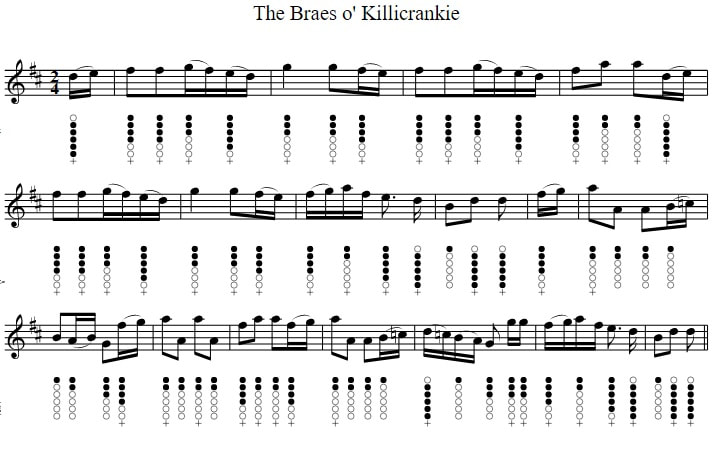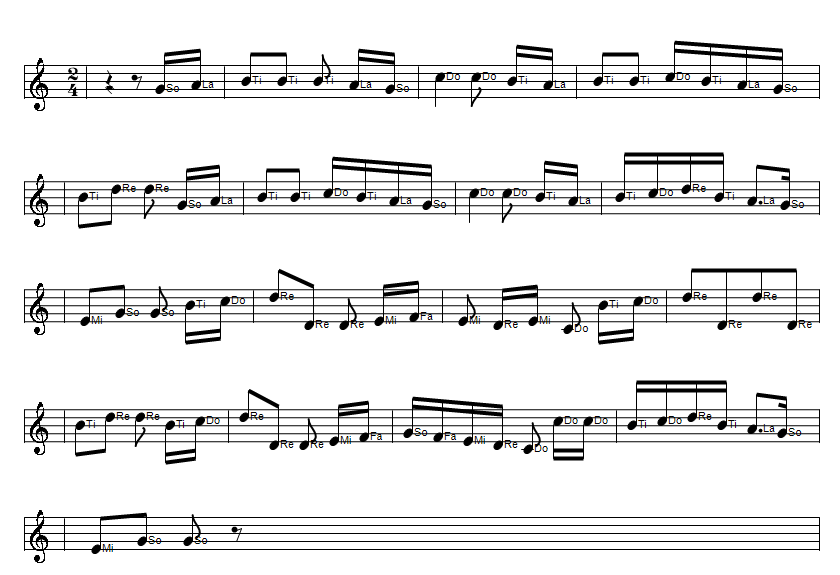The Braes O' killiecrankie Song Lyrics And Chords
The Corries, written by Robert Burns. 2/4. Guitar work by Marc. The sheet music is included. I also added a version of the tin whistle notes in a higher key of D Major.
The Braes O' Killiecrankie is a traditional Scottish song that dates back to the 17th century. Its lyrics tell the story of a battle that took place during the Jacobite Rising of 1689. The song has been passed down through generations and is still popular in Scotland today. Its haunting melody and powerful lyrics have made it a staple in Scottish folk music and have contributed to its enduring legacy. In this thesis, we will explore the origins of the Braes O' Killiecrankie, its historical significance, and its impact on Scottish culture.
Origins of the Song
The exact origins of the Braes O' Killiecrankie are uncertain, as is the case with many traditional folk songs. However, it is believed to have originated in the 17th century during the Jacobite Rising. The song was likely composed as a way to commemorate the Battle of Killiecrankie, which took place on July 27, 1689. This battle was a major event in the Jacobite Rising, a series of uprisings against the British government led by supporters of the exiled Stuart dynasty.
The Battle of Killiecrankie was fought between the Jacobite army, led by John Graham of Claverhouse, and the government forces, led by General Hugh Mackay. The Jacobites emerged victorious, but their leader, Graham, also known as Bonnie Dundee, was killed in the battle. It is believed that the Braes O' Killiecrankie was written as a tribute to him and his bravery.
Historical Significance
The Braes O' Killiecrankie is not just a song about a battle, but it also holds historical significance as it reflects the political and social climate of Scotland during the 17th century. The Jacobite Rising was a pivotal moment in Scottish history, as it represented the ongoing struggle between the Scottish and British governments. The lyrics of the song depict the loyalty and bravery of the Scottish soldiers who fought for their country and their cause.
The song also highlights the strong connection between the Scottish people and their land. The title, 'Braes O' Killiecrankie,' refers to a location in Perthshire, Scotland, known for its rugged and mountainous terrain. The lyrics describe the beauty of the landscape, with lines such as 'The braes o' Killiecrankie, where the heather is blooming,' showcasing the Scottish love for their homeland.
Impact on Scottish Culture
The Braes O' Killiecrankie has had a lasting impact on Scottish culture. It is often performed at Scottish gatherings and events, such as Highland games and ceilidhs. Its popularity has spread beyond Scotland, with versions of the song being recorded by various artists, including the famous Scottish folk band, The Corries.
The song has also been featured in various forms of media, such as films, television shows, and even video games. Its inclusion in these mediums has helped to introduce the song to new audiences, further solidifying its place in Scottish culture.
The Braes O' Killiecrankie is not just a song, but it is also a symbol of Scottish identity and pride. Its lyrics evoke a sense of nostalgia and patriotism, making it a beloved and treasured part of Scottish heritage. The song has been passed down through generations, with each rendition adding to its cultural significance.
Conclusion
In conclusion, the Braes O' Killiecrankie is a traditional Scottish song that holds great historical and cultural significance. Its origins in the Jacobite Rising, its depiction of Scottish loyalty and love for their land, and its enduring impact on Scottish culture make it a timeless piece of music. As long as the Scottish people continue to sing and pass down the Braes O' Killiecrankie, it will always be a reminder of the bravery and resilience of their ancestors.
Origins of the Song
The exact origins of the Braes O' Killiecrankie are uncertain, as is the case with many traditional folk songs. However, it is believed to have originated in the 17th century during the Jacobite Rising. The song was likely composed as a way to commemorate the Battle of Killiecrankie, which took place on July 27, 1689. This battle was a major event in the Jacobite Rising, a series of uprisings against the British government led by supporters of the exiled Stuart dynasty.
The Battle of Killiecrankie was fought between the Jacobite army, led by John Graham of Claverhouse, and the government forces, led by General Hugh Mackay. The Jacobites emerged victorious, but their leader, Graham, also known as Bonnie Dundee, was killed in the battle. It is believed that the Braes O' Killiecrankie was written as a tribute to him and his bravery.
Historical Significance
The Braes O' Killiecrankie is not just a song about a battle, but it also holds historical significance as it reflects the political and social climate of Scotland during the 17th century. The Jacobite Rising was a pivotal moment in Scottish history, as it represented the ongoing struggle between the Scottish and British governments. The lyrics of the song depict the loyalty and bravery of the Scottish soldiers who fought for their country and their cause.
The song also highlights the strong connection between the Scottish people and their land. The title, 'Braes O' Killiecrankie,' refers to a location in Perthshire, Scotland, known for its rugged and mountainous terrain. The lyrics describe the beauty of the landscape, with lines such as 'The braes o' Killiecrankie, where the heather is blooming,' showcasing the Scottish love for their homeland.
Impact on Scottish Culture
The Braes O' Killiecrankie has had a lasting impact on Scottish culture. It is often performed at Scottish gatherings and events, such as Highland games and ceilidhs. Its popularity has spread beyond Scotland, with versions of the song being recorded by various artists, including the famous Scottish folk band, The Corries.
The song has also been featured in various forms of media, such as films, television shows, and even video games. Its inclusion in these mediums has helped to introduce the song to new audiences, further solidifying its place in Scottish culture.
The Braes O' Killiecrankie is not just a song, but it is also a symbol of Scottish identity and pride. Its lyrics evoke a sense of nostalgia and patriotism, making it a beloved and treasured part of Scottish heritage. The song has been passed down through generations, with each rendition adding to its cultural significance.
Conclusion
In conclusion, the Braes O' Killiecrankie is a traditional Scottish song that holds great historical and cultural significance. Its origins in the Jacobite Rising, its depiction of Scottish loyalty and love for their land, and its enduring impact on Scottish culture make it a timeless piece of music. As long as the Scottish people continue to sing and pass down the Braes O' Killiecrankie, it will always be a reminder of the bravery and resilience of their ancestors.
Whaur [E]hae ye been sae [A]braw, lad?
Whaur [E]hae ye been sae [B7]brankie-o?
Whaur [E]hae ye been sae [A]braw, lad?
Cam' [E]ye by [B7]Killie[A]crankie-[E]o?
Chorus
An' [E]ye had been whaur [A]I hae been
Ye [E]wadna been sae [B7]cantie-o
An' [E]ye had seen what [A]I hae seen
On the [E]braes o' [B7]Killie[A]crankie-[E]o
I [E]fought at land, I [A]fought at sea
At [E]hame I fought my [B7]auntie-o
But I [E]met the Devil [A]and Dundee
On the [E]braes o' [B7]Killie[A]crankie-[E]o
Chorus
The [E]bauld pit cur fell [A]in a furr
And [E]Clavers gat a [B7]clankie-o
And [E]I had fed an [A]Atholl gled
On the [E]braes o' [B7]Killie[A]crankie-[E]o
Chorus
Oh [E]fie, MacKay, What [A]gart ye lie
I' the [E]brush ayont the [B7]brankie-o?
Ye'd [E]better kiss'd King [A]Willie's loof
Than [E]come tae [B7]Killie[A]crankie-[E]o
Chorus
It's nae shame, it's nae shame
It's nae shame to shank ye-o
There's sour slaes on Athol braes
And the de'ils at [B7]Killie[A]crankie-[E]o
Chorus
Here's the guitar chords in the key of C
Whaur [C]hae ye been sae [F]braw, lad?
Whaur [C]hae ye been sae [G7]brankie-o?
Whaur [C]hae ye been sae [F]braw, lad?
Cam' [C]ye by [G7]Killie[F]crankie-[C]o?
Chorus
An' [C]ye had been whaur [F]I hae been
Ye [C]wadna been sae [G7]cantie-o
An' [C]ye had seen what [F]I hae seen
On the [C]braes o' [G7]Killie[F]crankie-[C]o
I [C]fought at land, I [F]fought at sea
At [C]hame I fought my [G7]auntie-o
But I [C]met the Devil [F]and Dundee
On the [C]braes o' [G7]Killie[F]crankie-[C]o
Chorus
The [C]bauld pit cur fell [F]in a furr
And [C]Clavers gat a [G7]clankie-o
And [C]I had fed an [F]Atholl gled
On the [C]braes o' [G7]Killie[F]crankie-[C]o
Chorus
Oh [C]fie, MacKay, What [F]gart ye lie
I' the [C]brush ayont the [G7]brankie-o?
Ye'd [C]better kiss'd King [F]Willie's loof
Than [C]come tae [G7]Killie[F]crankie-[C]o
Chorus
It's nae shame, it's nae shame
It's nae shame to shank ye-o
There's sour slaes on Athol braes
And the de'ils at [G7]Killie[F]crankie-[C]o
Chorus
Whaur [C]hae ye been sae [F]braw, lad?
Whaur [C]hae ye been sae [G7]brankie-o?
Whaur [C]hae ye been sae [F]braw, lad?
Cam' [C]ye by [G7]Killie[F]crankie-[C]o?
Chorus
An' [C]ye had been whaur [F]I hae been
Ye [C]wadna been sae [G7]cantie-o
An' [C]ye had seen what [F]I hae seen
On the [C]braes o' [G7]Killie[F]crankie-[C]o
I [C]fought at land, I [F]fought at sea
At [C]hame I fought my [G7]auntie-o
But I [C]met the Devil [F]and Dundee
On the [C]braes o' [G7]Killie[F]crankie-[C]o
Chorus
The [C]bauld pit cur fell [F]in a furr
And [C]Clavers gat a [G7]clankie-o
And [C]I had fed an [F]Atholl gled
On the [C]braes o' [G7]Killie[F]crankie-[C]o
Chorus
Oh [C]fie, MacKay, What [F]gart ye lie
I' the [C]brush ayont the [G7]brankie-o?
Ye'd [C]better kiss'd King [F]Willie's loof
Than [C]come tae [G7]Killie[F]crankie-[C]o
Chorus
It's nae shame, it's nae shame
It's nae shame to shank ye-o
There's sour slaes on Athol braes
And the de'ils at [G7]Killie[F]crankie-[C]o
Chorus
Here's the guitar chords in the key of G
Whaur [G]hae ye been sae [C]braw, lad?
Whaur [G]hae ye been sae [D7]brankie-o?
Whaur [G]hae ye been sae [C]braw, lad?
Cam' [G]ye by [D7]Killie[C]crankie-[G]o?
Chorus
An' [G]ye had been whaur [C]I hae been
Ye [G]wadna been sae [D7]cantie-o
An' [G]ye had seen what [C]I hae seen
On the [G]braes o' [D7]Killie[C]crankie-[G]o
I [G]fought at land, I [C]fought at sea
At [G]hame I fought my [D7]auntie-o
But I [G]met the Devil [C]and Dundee
On the [G]braes o' [D7]Killie[C]crankie-[G]o
Chorus
The [G]bauld pit cur fell [C]in a furr
And [G]Clavers gat a [D7]clankie-o
And [G]I had fed an [C]Atholl gled
On the [G]braes o' [D7]Killie[C]crankie-[G]o
Chorus
Oh [G]fie, MacKay, What [C]gart ye lie
I' the [G]brush ayont the [D7]brankie-o?
Ye'd [G]better kiss'd King [C]Willie's loof
Than [G]come tae [D7]Killie[C]crankie-[G]o
Chorus
It's nae shame, it's nae shame
It's nae shame to shank ye-o
There's sour slaes on Athol braes
And the de'ils at [D7]Killie[C]crankie-[G]o
Whaur [G]hae ye been sae [C]braw, lad?
Whaur [G]hae ye been sae [D7]brankie-o?
Whaur [G]hae ye been sae [C]braw, lad?
Cam' [G]ye by [D7]Killie[C]crankie-[G]o?
Chorus
An' [G]ye had been whaur [C]I hae been
Ye [G]wadna been sae [D7]cantie-o
An' [G]ye had seen what [C]I hae seen
On the [G]braes o' [D7]Killie[C]crankie-[G]o
I [G]fought at land, I [C]fought at sea
At [G]hame I fought my [D7]auntie-o
But I [G]met the Devil [C]and Dundee
On the [G]braes o' [D7]Killie[C]crankie-[G]o
Chorus
The [G]bauld pit cur fell [C]in a furr
And [G]Clavers gat a [D7]clankie-o
And [G]I had fed an [C]Atholl gled
On the [G]braes o' [D7]Killie[C]crankie-[G]o
Chorus
Oh [G]fie, MacKay, What [C]gart ye lie
I' the [G]brush ayont the [D7]brankie-o?
Ye'd [G]better kiss'd King [C]Willie's loof
Than [G]come tae [D7]Killie[C]crankie-[G]o
Chorus
It's nae shame, it's nae shame
It's nae shame to shank ye-o
There's sour slaes on Athol braes
And the de'ils at [D7]Killie[C]crankie-[G]o
Killiekrankie Tin Whistle Sheet Music Notes
Killiekrankie standard sheet music notes in solfege [ Do Re Mi ] format.






